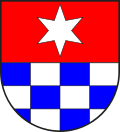Wages GR
| GR is the abbreviation for the canton of Graubünden in Switzerland and is used to avoid confusion with other entries in the name wage . |
| wage | |
|---|---|
| State : |
|
| Canton : |
|
| Region : | Viamala |
| BFS no. : | 3707 |
| Postal code : | 7433 |
| Coordinates : | 752 223 / 168610 |
| Height : | 1585 m above sea level M. |
| Height range : | 804–2292 m above sea level M. |
| Area : | 8.17 km² |
| Residents: | 46 (December 31, 2018) |
| Population density : | 6 inhabitants per km² |
| Website: | www.lohn-gr.ch |
|
Wages GR |
|
| Location of the municipality | |
Lohn ( Romansh Lon ) is a municipality in the Viamala region in the Swiss canton of Graubünden . It is located 13 km south of Thusis .
coat of arms
Blazon : Divided, a silver (white) six-pointed star in red above, sheathed in blue and silver below
The star stands for the Marian patronage of the church in Lohn , the lower part of the shield refers to the administrators of the episcopal county of Schams: the barons of Vaz .
geography
Lohn is a clustered village on Schamserberg on a terrace on the eastern slope of Piz Beverin and the highest municipality in the Schams region . Of the entire municipal area of 814 hectares, 461 hectares are agriculturally usable, but the majority of it is only used as a meadow. A further 284 hectares are covered by forest and wood, 57 hectares are unproductive areas (mostly mountains) and 12 hectares are settlement areas.
population
| Population development | ||||||||||||
|---|---|---|---|---|---|---|---|---|---|---|---|---|
| year | 1780 | 1850 | 1900 | 1950 | 1980 | 1990 | 2000 | 2005 | 2010 | 2012 | 2014 | 2016 |
| Residents | 126 | 97 | 75 | 62 | 36 | 48 | 50 | 50 | 46 | 42 | 41 | 44 |
languages
The original language of the inhabitants is Sutselvisch , a Graubünden Romance dialect. Until 1980 the residents spoke Romansh almost exclusively (1880 96%, 1910 100%, 1941 90% and 1980 100%). Since then, German has spread more and more through immigration and language changes. A small majority of the residents still speak Romansh, which, together with German, is the official language.
| Languages in wages | ||||||
| languages | 1980 census | 1990 census | 2000 census | |||
| number | proportion of | number | proportion of | number | proportion of | |
| German | 0 | 0.00% | 18th | 37.50% | 24 | 48.00% |
| Romansh | 36 | 100% | 30th | 62.50% | 26th | 52.00% |
| Residents | 36 | 100% | 48 | 100% | 50 | 100% |
nationality
At the end of 2005, 49 of the 50 residents were Swiss nationals.
politics
The municipal council consists of five people.
economy
The population traditionally lives from meadow cultivation and livestock.
traffic
Lohn is away from the main roads, but has a connection to the public transport network with the Zillis – Lohn – Wergenstein post bus line . The closest motorway connection is Zillis on the A13 .
history
The community has been settled since the 9th century. At that time in a Carolingian Empire Urbar a church in mood mentioned. As early as 1204 there was a community of free farmers with their own lower court. Various rulers exercised their sovereignty in the Middle Ages. In 1458 the community bought itself free from the feudal lord at the time, the Bishop of Chur. In the middle of the 16th century, the community joined the Reformation .
Attractions
The reformed village church is worth seeing . The two towers are a curiosity, which suggests two different eras. A first tower was probably built in the 12th century, a late Romanesque building with a semicircular apse, largely attached to the original structure, only around 1500, although the construction of the campanile was not even intended. During research work in 1953/54 fragments of paintings in the style of the Waltensburg master came to light, which were probably painted over at a later point in time due to carelessness and are no longer visible today.
The beneficiary house next to it from the mid-16th century housed the village school until 1948 and, after renovation, now serves as a community center. It is a unique building for Schams, reminiscent of a Walser house .
The cultural project of the tùn resùn sound forest has existed in the Lohner forest area since 2005 .
literature
- 200 years of the canton of Graubünden. The municipalities of the canton of Graubünden. Rüegger, Chur / Zurich 2003. ISBN 3-7253-0741-5 .
- Jürg Simonett: wages (GR). In: Historical Lexicon of Switzerland . 2009 .
Web links
Individual evidence
- ↑ Permanent and non-permanent resident population by year, canton, district, municipality, population type and gender (permanent resident population). In: bfs. admin.ch . Federal Statistical Office (FSO), August 31, 2019, accessed on December 22, 2019 .




